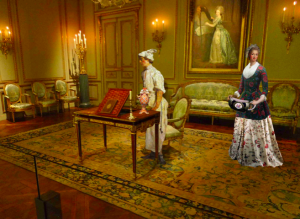 Male servants were not uncommon in France during the eighteenth century. However, despite their presence in eighteenth century French history, they are not often represented in art. This male servant comes from a [1736-]1738 painting entitled The Waiter by renowned French artist, Jean-Baptiste Siméon Chardin. In the painting from which this image was selected, the male servant appears to perform one of his daily tasks by pouring a liquid into a large basin. However, within the Tessé Room, the male servant is placed by the mechanical Riesener table. Here, he opens various compartments, making sure to remove any dust inside.
Male servants were not uncommon in France during the eighteenth century. However, despite their presence in eighteenth century French history, they are not often represented in art. This male servant comes from a [1736-]1738 painting entitled The Waiter by renowned French artist, Jean-Baptiste Siméon Chardin. In the painting from which this image was selected, the male servant appears to perform one of his daily tasks by pouring a liquid into a large basin. However, within the Tessé Room, the male servant is placed by the mechanical Riesener table. Here, he opens various compartments, making sure to remove any dust inside.
The female servant in the Tessé Room, constructed from various paintings and costumes in the Metropolitan Museum’s collection, perfectly exemplifies the second-hand clothing trade market in eighteenth century Paris. This booming market was an essential part of Parisian history, allowing self-invention and illusions of luxury. The Parisian upper-class created a thriving consumption economy which lower-classes, particularly servants, had the ability to access indirectly. Through this new economy, people with less means had the ability to transform themselves, creating the appearance of wealth in their everyday lives. Here, the servant’s dress seems to be as glamorous as the beautifully ornate chamber pot she carries, created by the same porcelain company as the vase that lies on the desk, the Sèvres Manufactory.